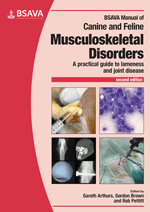
Full text loading...

This chapter provides a practical guide to performing, and interpreting the results of, a range of sampling techniques. The key techniques covered are synovial fluid collection and analysis, serological analysis, synovial membrane and periarticular tissue biopsy, bone biopsy and muscle biopsy.
Sampling and laboratory investigation, Page 1 of 1
< Previous page | Next page > /docserver/preview/fulltext/10.22233/9781910443286/9781910443286.4-1.gif

Full text loading...























